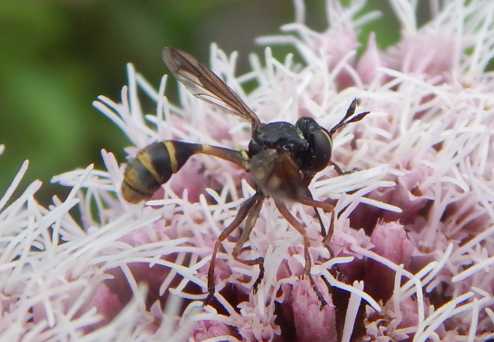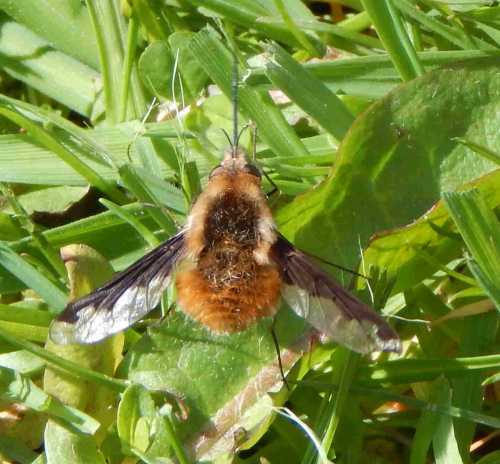Conopid Flies - Parasitoids Of Bees
Conopid Flies - or flies belonging to the family Conopidae, are endoparasitoids of bees. An endoparasitoid is a parasite that lives inside the body of another creature, and ultimately kills it.
They look a little like solitary wasps or Nomada bees, however, a key give away that these are actually flies is revealed in the short antennae to the front of the head, the fact that (as with all flies) this insect has only one pair of wings (whereas wasps and Nomada bees have 2 pairs) and the large, forward-facing bulbous eyes.
The females rest on flowers, awaiting passing bumble bees or honey bees. They then attack passing bees in flight - or sometimes catch bees as they forage on flowers.
Upon landing on the bee, the fly prises open a space between two of the bee's body segments, and inserts an egg into the soft body beneath the harder body cuticle (a type of protective shell covering).
Unfortunately for the bee, the egg hatches quite quickly inside the bee, and the emerging larvae feeds on the victim, eating it from the inside.
Before ultimately killing the host bee, the bee's behaviour changes. It spends less time in the nest, and ultimately will no longer return at night, instead seeking cooler locations away from the nest. Whilst still able to forage, research has shown that bees parasitized by conopid flies have a reduced capacity to carry nectar (Schmid-Hempel and Schmid-Hempel 1991).
 Above: The Conopid fly Physocephala rufipes on hemp agrimony. It is an endoparasite of many bumble bees species and species of wasp, such as the Red Wasp, Vespula rufa. This fly itself looks a little like a solitary wasp or Nomada species of bee, but has only one pair of wings, short antennae, and large, forward-facing eyes - it's a fly of the insect order Diptera.
Above: The Conopid fly Physocephala rufipes on hemp agrimony. It is an endoparasite of many bumble bees species and species of wasp, such as the Red Wasp, Vespula rufa. This fly itself looks a little like a solitary wasp or Nomada species of bee, but has only one pair of wings, short antennae, and large, forward-facing eyes - it's a fly of the insect order Diptera.Eventually, the host bee buries itself in soil (read more about why bees may be seen digging into ground). The conopid fly then overwinters under ground in the body of the host bee, and emerges the following year, now an adult conopid fly, ready to attack more bees and begin the cycle again.
Competition Between Conopid Flies
Interestingly, it has been reported that a single host bee may be attacked multiple times, resulting in competition between the parasites inside the body of the host bee - a contest that only one conopid fly shall win, with the death of competing flies (Clausen 1940; Schmid-Hempel and Schmid-Hempel 1989, 1996).
Do Conopid Flies Only Attack Bumble Bees?
Conopid flies are commonly associated with honey bees and social bumble bees. Having no sharp ovipositor for piercing the cuticle, it seems cuckoo bumble bees are avoided (they have a tougher exoskeleton).
However, conopid flies have also been observed to attack Euglossine species - Eulaema - a genus of large-bodied euglossine bees that occur primarily in the Neotropics.
- notably the Large Orchid Bee (1).
Refs:
(1) Rasmussen, Claus. (2009). Conopid Fly (Diptera: Conopidae) Attacking Large Orchid Bees (Hymenoptera: Apidae: Eulaema). Journal of the Kansas Entomological Society. 77. 61-62. 10.2317/0306.16.1.
If you found this page helpful or interesting, I'd really be grateful if you would share it with others - if not this page, perhaps another, such as Gardening For Bees.
Thank you so much :) .
